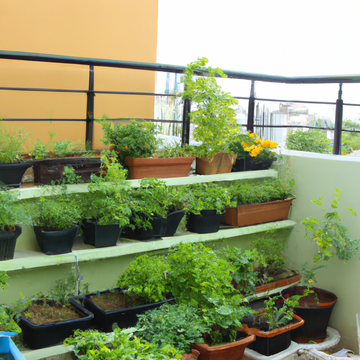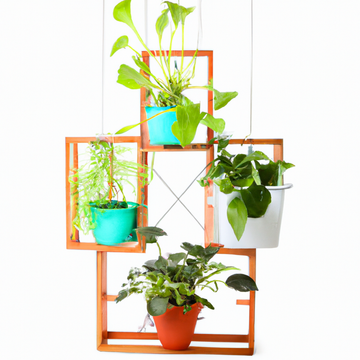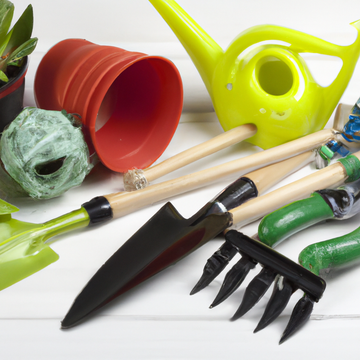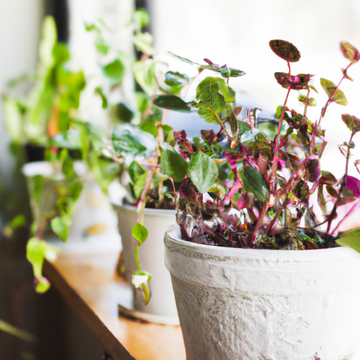Terrace Gardening: How to Grow a Garden on Your Terrace
by GOLDDUST- Rethink&Revive on Apr 20, 2023

Are you tired of living in a concrete jungle with no greenery to soothe your eyes? Do you wish to grow a garden but don't have enough space? Worry not, as terrace gardening is here to save the day! Terrace gardening is an innovative way of growing plants on your rooftop or balcony. It not only adds aesthetic appeal to your home but also provides numerous health benefits. In this blog post, we will explore everything you need to know about terrace gardening- from its different types and benefits to planting techniques and maintenance tips. So get ready for some green inspiration and learn how you can create a lush oasis right at home!
What is Terrace Gardening?
Terrace gardening is a form of gardening where plants are grown on rooftops, balconies, or any other elevated platform. It involves the cultivation of various types of plants ranging from vegetables, fruits to flowers in containers that can be easily moved around.
Terrace gardens come in different shapes and sizes depending on the available space and one's imagination. They can be created using pots, grow bags or hydroponic systems.
One significant advantage of terrace gardening is that it enables people living in urban areas to enjoy fresh produce without having to travel long distances to buy them. Additionally, it helps reduce heat absorption and air pollution while providing insulation during cold seasons.
However, creating a thriving terrace garden requires proper planning such as selecting suitable plants for your climate zone and understanding their growing requirements. It also entails proper maintenance which includes watering regularly and applying organic fertilizers like seaweed fertilizer or neem oil for plants.
Terrace Gardening provides an innovative way for individuals with limited outdoor spaces to partake in sustainable agriculture while adding aesthetic value to their homes or apartments.
The Benefits of Terrace Gardening
Terrace gardening is one of the most popular hobbies among people who live in apartments or have limited outdoor space. Not only does it provide a natural and healthy environment, but it also offers several benefits that can improve your physical and mental well-being.
One of the main advantages of terrace gardening is that it allows you to grow your own fresh produce. This means you can enjoy organic vegetables, fruits, and herbs without having to worry about harmful chemicals or pesticides.
Terrace gardening also helps to reduce stress by providing a peaceful and relaxing environment. Gardening has been proven to lower blood pressure, decrease anxiety levels, and promote relaxation.
Another benefit of terrace gardening is that it encourages physical activity. Gardening involves bending, squatting, digging, planting - all these activities are great forms of exercise for both young and old alike.
Terrace gardens also help purify the air by absorbing carbon dioxide and releasing oxygen into the atmosphere. They act as natural air filters which greatly enhance air quality in urban areas.
Moreover, growing plants on your terrace promotes biodiversity as plants attract beneficial insects such as bees which play an essential role in pollination- thus improving plant growth overall!
In summary, terrace gardens offer many benefits from promoting health & wellness through reducing stress levels while providing fresh produce for consumption – so why not start one today?
The Different Types of Terrace Gardens
When it comes to terrace gardening, there are several types of gardens that you can create based on your preferences and the amount of space available. The most popular types include container gardens, vertical gardens, raised bed gardens, and hydroponic or aeroponic systems.
Container Gardens:
These are ideal for small spaces as they involve growing plants in pots or grow bags placed on a terrace. You can use any type of container like plastic pots, clay pots or even recycled containers for this purpose. Container gardening is perfect if you want to grow herbs, flowers or vegetables.
Vertical Gardens:
This involves using walls or trellises to support plants vertically instead of horizontally across the ground. This type is great for saving space while still allowing you to grow a variety of plants such as ivy, tomatoes and strawberries.
Raised Bed Gardens:
These are constructed by creating beds above the ground level using materials like wood planks or concrete blocks with soil added inside them. They offer good drainage and make it easy to control weeds while providing good air circulation around plant roots.
Hydroponic/Aeroponic Systems:
These systems involve growing plants in water instead of soil which makes them suitable for those who don't have access to fertile soil but still want fresh produce from their garden. Hydroponic/aeroponic systems require special equipment but allow you complete control over nutrient levels making them efficient at producing high yields with little maintenance required.
By choosing one (or more) of these options based on your needs and preferences – whether it be limited space available or not having enough time for regular maintenance – anyone can enjoy the benefits that come with terrace gardening!
How to Plant a Terrace Garden
Planting a terrace garden might seem like a daunting task, but it's actually quite simple. With the right tools and techniques, you can create a beautiful and functional garden on your terrace.
Firstly, choose the right containers for your plants. Grow bags are an excellent option as they are portable and come in various sizes to fit any space. Fill them with well-draining soil mixed with organic fertilizers such as mustard cake fertilizer or seaweed fertilizer.
Next, select the plants suitable for terrace gardening. Opt for small-sized vegetables such as cherry tomatoes, peppers, beans or herbs that don't require too much space to grow. Choose varieties that complement each other so that they can share nutrients.
Once you've chosen your plants, arrange them according to their required amount of sunlight exposure - place those needing more sun towards south-facing areas while shade-loving ones should be placed in north-facing locations.
After placing them correctly, water the plants regularly using neem oil for plants which is an effective natural pesticide against insects and diseases without harming beneficial organisms in the soil. Additionally adding neem cake powder helps improve soil health by adding nitrogen and phosphorus content to it.
Monitor your terrace garden closely ensuring no overwatering or underwatering occurs during hot weather conditions whilst also feeding them once every two weeks with organic fertilizers
In conclusion planting a Terrace Garden takes some planning but proper guidance ensures success.
Tips for Maintaining Your Terrace Garden
Maintaining a terrace garden requires effort and consistency. Here are some tips to keep your garden healthy:
1. Watering: Water your plants regularly but do not over-water them. Over-watering can lead to root rot, while under-watering can cause plants to wilt.
2. Fertilizing: Use organic fertilizers such as mustard cake fertilizer, neem cake powder, seaweed fertilizer or any other organic fertilizers instead of chemical ones for better results.
3. Pruning: Regular pruning is essential for maintaining the shape and health of the plant. Trim off dead leaves and branches and pinch back new growth.
4. Pest Control: Neem oil for plants is an excellent natural insecticide that keeps pests at bay without harming the environment or beneficial insects like bees or butterflies.
5. Sunlight Exposure: Ensure that each plant gets enough sunlight and does not become shaded by taller plants around it.
6. Soil Quality: Replace old soil with fresh potting mix every few months to maintain soil quality as it tends to lose its nutrients quickly in pots
By following these simple tips you can enjoy your green space year-round without facing major issues!
Conclusion
Terrace gardening is a wonderful way to bring greenery into your life even if you don't have access to a traditional garden. With the right tools and techniques, anyone can start their own terrace garden and enjoy fresh produce and beautiful plants all year round.
By using organic fertilizers like mustard cake fertilizer, neem oil for plants, seaweed fertilizer, neem cake powder and adopting organic gardening practices in your terrace garden, you not only protect the environment but also ensure healthy growth of your plants.
Remember that maintaining a terrace garden requires regular care and attention. But with patience and dedication comes the joy of watching your little patch of nature flourish under your loving touch.
So why wait? Start planning out your own mini-garden today! Happy gardening!




